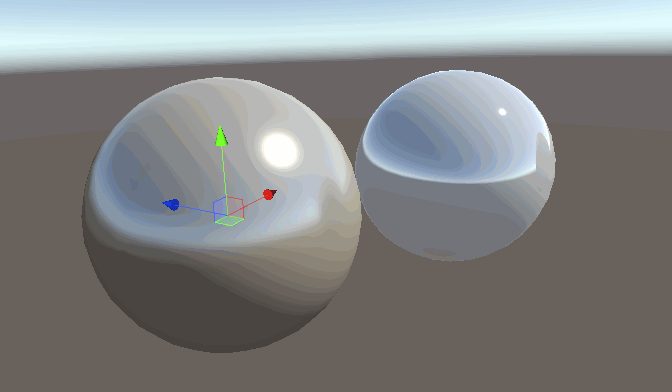上一篇文章我们说了 BRDF
https://blog.csdn.net/A13155283231/article/details/111665581
这篇来说说IBL部分 (虽然也是复制粘贴😂)
直接跳过lightmap部分哈

引入
这部分就没啥公式了,我的简单理解就是
Unity内置的Standard的IBL就是利用三个元素
- cubemap (由probe采样得到,存入unity_SpecCube0)
- mipmap
- roughness
- 然后利用反射公式采样那张贴图(cubemap)
- 利用roughness来控制mipmap的级别,从而根据粗糙度得到更模糊的图像
代码部分
上完整 shader
Shader "Unlit/MyBRDFIBL"
{
Properties
{
_MainTex ("Texture", 2D) = "white" {}
_Smoothness("Smoothness",Range(0,1))=0.5
}
SubShader
{
Tags { "RenderType"="Opaque"}
Pass
{
Tags {"LightMode"="ForwardBase"}
CGPROGRAM
#pragma vertex vert
#pragma fragment frag
#pragma multi_compile_fwdbase
#include "UnityCG.cginc"
#include "UnityShaderVariables.cginc"
#include "UnityStandardConfig.cginc"
#include "UnityLightingCommon.cginc"
struct a2v
{
float4 vertex : POSITION;
float2 uv : TEXCOORD0;
float3 normal:NORMAL;
float4 tangent:TANGENT;
};
struct v2f
{
float4 pos : SV_POSITION;
float3 normal:TEXCOORD1;
float3 tangent:TEXCOORD3;
float2 uv : TEXCOORD0;
float3 worldPos:TEXCOORD2;
};
#define PI 3.14159265f
sampler2D _MainTex;
float4 _MainTex_ST;
half _Smoothness;
// Pow5 uses the same amount of instructions as generic pow(), but has 2 advantages:
// 1) better instruction pipelining
// 2) no need to worry about NaNs
inline half Pow5 (half x)
{
return x*x * x*x * x;
}
inline half2 Pow5 (half2 x)
{
return x*x * x*x * x;
}
inline half3 Pow5 (half3 x)
{
return x*x * x*x * x;
}
inline half4 Pow5 (half4 x)
{
return x*x * x*x * x;
}
// Smoothness is the user facing name
// it should be perceptualSmoothness but we don't want the user to have to deal with this name
half SmoothnessToRoughness(half smoothness)
{
return (1 - smoothness) * (1 - smoothness);
}
float SmoothnessToPerceptualRoughness(float smoothness)
{
return (1 - smoothness);
}
float PerceptualRoughnessToRoughness(float perceptualRoughness)
{
return perceptualRoughness * perceptualRoughness;
}
half RoughnessToPerceptualRoughness(half roughness)
{
return sqrt(roughness);
}
half perceptualRoughnessToMipmapLevel(half perceptualRoughness)
{
return perceptualRoughness * UNITY_SPECCUBE_LOD_STEPS;
}
v2f vert (a2v v)
{
v2f o;
o.pos = UnityObjectToClipPos(v.vertex);
o.uv = TRANSFORM_TEX(v.uv, _MainTex);
o.worldPos = mul(unity_ObjectToWorld,v.vertex);
o.normal = UnityObjectToWorldNormal(v.normal);
o.tangent = UnityObjectToWorldNormal(v.tangent);
return o;
}
// Note: Disney diffuse must be multiply by diffuseAlbedo / PI. This is done outside of this function.
half DisneyDiffuse(half NdotV, half NdotL, half LdotH, half perceptualRoughness)
{
half fd90 = 0.5 + 2 * LdotH * LdotH * perceptualRoughness;
// Two schlick fresnel term
half lightScatter = (1 + (fd90 - 1) * Pow5(1 - NdotL));
half viewScatter = (1 + (fd90 - 1) * Pow5(1 - NdotV));
return lightScatter * viewScatter;
}
// Ref: http://jcgt.org/published/0003/02/03/paper.pdf
inline float SmithJointGGXVisibilityTerm (float NdotL, float NdotV, float roughness)
{
// Approximation of the above formulation (simplify the sqrt, not mathematically correct but close enough)
float a = roughness;
float lambdaV = NdotL * (NdotV * (1 - a) + a);
float lambdaL = NdotV * (NdotL * (1 - a) + a);
#if defined(SHADER_API_SWITCH)
return 0.5f / (lambdaV + lambdaL + 1e-4f); // work-around against hlslcc rounding error
#else
return 0.5f / (lambdaV + lambdaL + 1e-5f);
#endif
}
inline float GGXTerm (float NdotH, float roughness)
{
float a2 = roughness * roughness;
float d = (NdotH * a2 - NdotH) * NdotH + 1.0f; // 2 mad
return UNITY_INV_PI * a2 / (d * d + 1e-7f); // This function is not intended to be running on Mobile,
// therefore epsilon is smaller than what can be represented by half
}
inline half3 FresnelTerm (half3 F0, half cosA)
{
half t = Pow5 (1 - cosA); // ala Schlick interpoliation
return F0 + (1-F0) * t;
}
inline half3 FresnelLerp (half3 F0, half3 F90, half cosA)
{
half t = Pow5 (1 - cosA); // ala Schlick interpoliation
return lerp (F0, F90, t);
}
half3 Unity_GlossyEnvironment (UNITY_ARGS_TEXCUBE(tex), half4 hdr, half3 worldViewDir, half3 Normal, half roughness)
{
half perceptualRoughness = roughness /* perceptualRoughness */ ;
// TODO: CAUTION: remap from Morten may work only with offline convolution, see impact with runtime convolution!
// For now disabled
#if 0
float m = PerceptualRoughnessToRoughness(perceptualRoughness); // m is the real roughness parameter
const float fEps = 1.192092896e-07F; // smallest such that 1.0+FLT_EPSILON != 1.0 (+1e-4h is NOT good here. is visibly very wrong)
float n = (2.0/max(fEps, m*m))-2.0; // remap to spec power. See eq. 21 in --> https://dl.dropboxusercontent.com/u/55891920/papers/mm_brdf.pdf
n /= 4; // remap from n_dot_h formulatino to n_dot_r. See section "Pre-convolved Cube Maps vs Path Tracers" --> https://s3.amazonaws.com/docs.knaldtech.com/knald/1.0.0/lys_power_drops.html
perceptualRoughness = pow( 2/(n+2), 0.25); // remap back to square root of real roughness (0.25 include both the sqrt root of the conversion and sqrt for going from roughness to perceptualRoughness)
#else
// MM: came up with a surprisingly close approximation to what the #if 0'ed out code above does.
perceptualRoughness = perceptualRoughness*(1.7 - 0.7*perceptualRoughness);
#endif
half mip = perceptualRoughnessToMipmapLevel(perceptualRoughness);
half3 R = reflect(-worldViewDir, Normal);
half4 rgbm = UNITY_SAMPLE_TEXCUBE_LOD(tex, R, mip);
return DecodeHDR(rgbm, hdr);
}
fixed4 frag (v2f i) : SV_Target
{
// sample the texture
fixed4 col = tex2D(_MainTex, i.uv);
float3 worldViewDir = normalize(UnityWorldSpaceViewDir(i.worldPos)) ;
float3 worldLightDir = normalize(UnityWorldSpaceLightDir(i.worldPos)) ;
float3 worldNormal = normalize(i.normal);
float3 worldTangent = normalize(i.tangent);
float3 worldHalfDir = normalize(worldViewDir + worldLightDir);
half NoH = saturate(dot(worldNormal, worldHalfDir));
half VoH = saturate(dot(worldViewDir, worldHalfDir));
half NoV = saturate(dot(worldNormal, worldViewDir));
half NoL = saturate(dot(worldNormal, worldLightDir));
half LoV = saturate(dot(worldLightDir, worldViewDir));
half LoH = saturate(dot(worldLightDir, worldHalfDir));
float perceptualRoughness = SmoothnessToPerceptualRoughness (_Smoothness);
half3 diffuse = DisneyDiffuse(NoH, NoL, LoH, perceptualRoughness) * NoL;
float roughness = PerceptualRoughnessToRoughness(perceptualRoughness);
roughness = max(roughness, 0.002);
float V = SmithJointGGXVisibilityTerm (NoL, NoV, roughness);
float D = GGXTerm (NoH, roughness);
float3 F = FresnelTerm (half3(1,1,1), LoH);
float specularTerm = V * D * PI;
specularTerm = max(0, specularTerm * NoL);
// specularTerm *= any(specColor) ? 1.0 : 0.0;
half3 specular = specularTerm * F;
half3 ibl = Unity_GlossyEnvironment(UNITY_PASS_TEXCUBE(unity_SpecCube0), unity_SpecCube1_HDR, worldViewDir, worldNormal, perceptualRoughness);
half grazingTerm = saturate(_Smoothness/* + (1-oneMinusReflectivity) */);
col.xyz = diffuse * _LightColor0.rgb
+ specular * _LightColor0.rgb
+ ibl * FresnelLerp(half3(1,1,1) /* specColor */, grazingTerm, NoV);
col.xyz = col.xyz / 2;
return col;
}
ENDCG
}
}
}
























 3726
3726











 被折叠的 条评论
为什么被折叠?
被折叠的 条评论
为什么被折叠?








